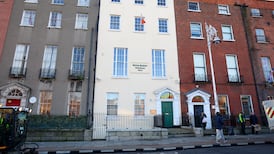The builders are about to move in to restore one of the last remaining consistorial courts in Ireland, places where bishops tried offenders accused of breaches of church law.
Within the historic precinct of Christ Church Cathedral in Waterford, the ecclesiastical legal venue is a smaller version of the traditional public courtroom, with a raised bench where the presiding prelate sat.
Before 1858 the bishops of the established church held many powers which are now exercised by the State. Most of their consistorial court work involved, for example, the proving of wills and the granting of marriage licences, and they were responsible for the granting of divorces.
They also tried people accused of acts such as sacrilege and adultery which, though not crimes against the State, broke the laws of the church. Enormous numbers of people appeared before such courts accused of fornication. How the primary evidence was gathered in such cases is a matter of speculation.
The penalties imposed on the unfortunate offenders often involved some public humiliation. Historian Julian Walton says the penitents were usually commanded to appear in church on the following Sunday wearing penitential garb. Later, as the Church of Ireland became impecunious, fines were favoured.
Such records of the consistorial courts as survived were, for the most part, placed in the Public Record Office in Dublin when the church was disestablished - deprived of its State connection and official position - in 1871.
All of these were destroyed in during the siege of the Four Courts in June 1922. A few records of individual courts were stored elsewhere, however, and these are still accessible to historians as a fascinating chronicle of a time when the established church had enormous power.
Waterford's consistorial court is damp and in bad repair and is targeted for restoration in phase two of Conservation 2000, the major project to restore the entire cathedral.
Phase one, just completed at a cost of £250,000, entailed cleaning and repairing the steeple and exterior and interior stone and plaster work. It also exposed a section of a massive ancient pillar, part of the original medieval Christ Church Cathedral which was replaced by the present building in the 18th century.
Freshly painted, Christ Church has regained much of its neo-classical splendour. With a history of Christian worship at this site for almost a thousand years, it is attracting increasing numbers of tourists. It is also proving to be a spacious and splendid venue for choral and other cultural events as the drive continues to raise the remainder of the £1.2 million overall cost of the project.
The administrator of Conservation 2000, Daphne Stewart Liberty, says support from all sides of the community has been enthusiastic and generous, but a massive fund-raising task still lies ahead.
The history of the Church of Ireland cathedral parallels that of Waterford over many centuries. Drawing upon this, it is hoped to stage a historic pageant in the cathedral several evenings a week next year. This will probably be based on the marriage of Strongbow and Aoife, which took place there in 1170.
On June 8th the cathedral will see a unique ecclesiastical occasion with the installation of both a dean and a bishop on the same night. The Bishop of Cashel and Ossory, the Right Rev John Neill, will be formally installed as Bi shop of Waterford, and the Rev Peter Barrett, now Dean of Residence at TCD, will be installed as the new Dean of Waterford.







